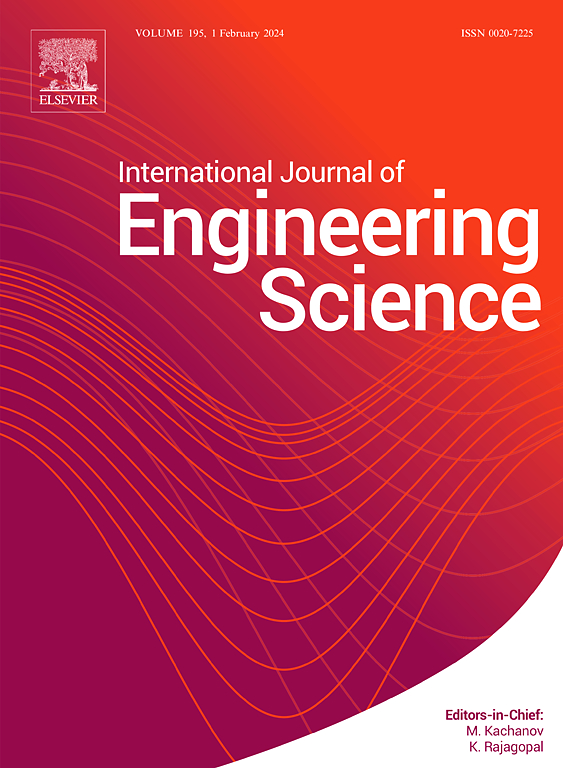Growth in biphasic tissue
IF 5.7
1区 工程技术
Q1 ENGINEERING, MULTIDISCIPLINARY
International Journal of Engineering Science
Pub Date : 2024-12-18
DOI:10.1016/j.ijengsci.2024.104183
引用次数: 0
Abstract
Continuum mechanical models for growth and remodelling of biological tissue are well suited for the description of physiological and pathological processes, such as bone remodelling, muscle adaption or the progression of a tumour. An overview of four selected growth models from the literature is given and fundamental kinematic and multiphasic approaches for open and closed systems are outlined. Beyond that, a biphasic model using the Theory of Porous Media is enhanced by the kinematic split of the deformation gradient for the study of a growing cylinder. Based on the analytical solution of the specific case without outflow, a novel growth approach is developed allowing a gradual consideration of the kinematic split. Subsequently, this approach is applied to the extended case with outflow and evaluated numerically. Herein, consolidating characteristics of growth that are driven by the interaction of fluid pressure and solid stress are identified. Finally, a numerical example of a growing body embedded in surrounding tissue shows that residual compressive stresses arise due to incompatible deformation.
双相组织生长
生物组织生长和重塑的连续力学模型非常适合描述生理和病理过程,如骨重塑、肌肉适应或肿瘤的进展。概述了从文献中选择的四种增长模型,并概述了开放和封闭系统的基本运动学和多相方法。除此之外,使用多孔介质理论的双相模型通过运动分裂的变形梯度来增强对生长圆柱体的研究。基于无外流的具体情况的解析解,提出了一种新的增长方法,允许逐步考虑运动分裂。随后,将该方法应用于有外流的扩展情况,并进行了数值计算。在此,确定了流体压力和固体应力相互作用驱动的生长固结特征。最后,一个生长体嵌入周围组织的数值例子表明,由于不相容变形而产生残余压应力。
本文章由计算机程序翻译,如有差异,请以英文原文为准。
求助全文
约1分钟内获得全文
求助全文
来源期刊

International Journal of Engineering Science
工程技术-工程:综合
CiteScore
11.80
自引率
16.70%
发文量
86
审稿时长
45 days
期刊介绍:
The International Journal of Engineering Science is not limited to a specific aspect of science and engineering but is instead devoted to a wide range of subfields in the engineering sciences. While it encourages a broad spectrum of contribution in the engineering sciences, its core interest lies in issues concerning material modeling and response. Articles of interdisciplinary nature are particularly welcome.
The primary goal of the new editors is to maintain high quality of publications. There will be a commitment to expediting the time taken for the publication of the papers. The articles that are sent for reviews will have names of the authors deleted with a view towards enhancing the objectivity and fairness of the review process.
Articles that are devoted to the purely mathematical aspects without a discussion of the physical implications of the results or the consideration of specific examples are discouraged. Articles concerning material science should not be limited merely to a description and recording of observations but should contain theoretical or quantitative discussion of the results.
 求助内容:
求助内容: 应助结果提醒方式:
应助结果提醒方式:


